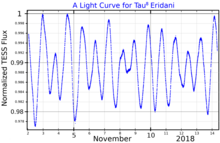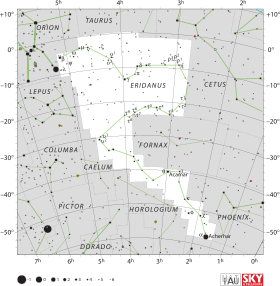Tau8 Eridani
| Ascension droite | 03h 53m 42,703s[2] |
|---|---|
| Déclinaison | −24° 36′ 44,03″[2] |
| Constellation | Éridan |
| Magnitude apparente | 4,63 à 4,65[3] |
Localisation dans la constellation : Éridan | |
| Type spectral | B6 V[4] |
|---|---|
| Indice U-B | −0,48[5] |
| Indice B-V | −0,13[5] |
| Variabilité | SPB[3] |
| Vitesse radiale | +20,5 ± 0,2 km/s[6] |
|---|---|
| Mouvement propre |
μα = +31,28 mas/a[2] μδ = −7,49 mas/a[2] |
| Parallaxe | 8,65 ± 0,30 mas[2] |
| Distance |
380 ± 10 al (116 ± 4 pc) |
| Magnitude absolue | −0,67[7] |
| Masse | 5,0 ± 0,1 M☉[8] |
|---|---|
| Gravité de surface (log g) | 4,00[9] |
| Luminosité | 256 L☉[10] |
| Température | 11 858 K[10] |
| Rotation | 30 km/s[4] |
| Âge | 32,8 ± 9,9 × 106 a[8] |
| Compagnon | τ8 Eri[11] |
|---|---|
| Excentricité (e) | 0,18 ± 0,02 |
| Période (P) | 459 ± 4 j |
| Argument du périastre (ω) | 106 ± 5° |
| Époque du périastre (τ) | 2 450 954 ± 7 JJ |
| Demi-amplitude (K1) | 21,7 ± 0,4 km/s |
Désignations
Tau8 Eridani (τ8 Eri) est une étoile binaire de la constellation de l'Éridan. Elle est visible à l'œil nu avec une magnitude apparente combinée de 4,65[5]. D'après la mesure de sa parallaxe annuelle par le satellite Hipparcos, le système est distant d'environ ∼ 380 a.l. (∼ 117 pc) de la Terre[2]. Il s'éloigne du Système solaire à une vitesse radiale de +20,5 km/s[6].
Tau8 Eridani est une binaire spectroscopique à raies simples avec une période orbitale d'environ 459 jours et une excentricité de 0,18[11]. Sa composante visible est une étoile bleu-blanc de la séquence principale de type spectral B6 V[4]. C'est une étoile de type B à pulsation lente qui connaît des variations de vitesse radiale à une fréquence de 1,156 9 fois par jour[13]. L'étoile est cinq fois plus massive que le Soleil et elle est estimée être âgée autour de 33 millions d'années[8]. Elle est 256 fois plus lumineuse que le Soleil et sa température de surface est de 11 858 K[10]. L'étoile pourrait posséder un champ magnétique longitudinal avec une force de −140 ± 71 G[14].
Notes et références[modifier | modifier le code]
- (en) Cet article est partiellement ou en totalité issu de l’article de Wikipédia en anglais intitulé « Tau8 Eridani » (voir la liste des auteurs).
- (en) « MAST: Barbara A. Mikulski Archive for Space Telescopes », Space Telescope Science Institute (consulté le )
- (en) F. van Leeuwen, « Validation of the new Hipparcos reduction », Astronomy & Astrophysics, vol. 474, no 2, , p. 653–664 (DOI 10.1051/0004-6361:20078357, Bibcode 2007A&A...474..653V, arXiv 0708.1752)
- « VSX : Detail for tau 8 Eri », sur The International Variable Star Index, AAVSO (consulté le )
- (en) Helmut A. Abt, Hugo Levato et Monica Grosso, « Rotational Velocities of B Stars », The Astrophysical Journal, vol. 573, no 1, , p. 359-365 (DOI 10.1086/340590, Bibcode 2002ApJ...573..359A)
- (en) H. L. Johnson et al., « UBVRIJKL photometry of the bright stars », Communications of the Lunar and Planetary Laboratory, vol. 4, no 99, (Bibcode 1966CoLPL...4...99J)
- (en) D. Pourbaix et al., « SB9: The ninth catalogue of spectroscopic binary orbits », Astronomy & Astrophysics, vol. 424, , p. 727-732 (DOI 10.1051/0004-6361:20041213, Bibcode 2004A&A...424..727P, arXiv astro-ph/0406573)
- (en) E. Anderson et Ch. Francis, « XHIP: An extended Hipparcos compilation », Astronomy Letters, vol. 38, no 5, , p. 331 (DOI 10.1134/S1063773712050015, Bibcode 2012AstL...38..331A, arXiv 1108.4971)
- (en) N. Tetzlaff, R. Neuhäuser et M. M. Hohle, « A catalogue of young runaway Hipparcos stars within 3 kpc from the Sun », Monthly Notices of the Royal Astronomical Society, vol. 410, no 1, , p. 190–200 (DOI 10.1111/j.1365-2966.2010.17434.x, Bibcode 2011MNRAS.410..190T, arXiv 1007.4883)
- (en) K. Lefever et al., « Spectroscopic determination of the fundamental parameters of 66 B-type stars in the field-of-view of the CoRoT satellite », Astronomy & Astrophysics, vol. 515, , article no A74 (DOI 10.1051/0004-6361/200911956, Bibcode 2010A&A...515A..74L, arXiv 0910.2851)
- (en) I. McDonald, A. A. Zijlstra et M. L. Boyer, « Fundamental Parameters and Infrared Excesses of Hipparcos Stars », Monthly Notices of the Royal Astronomical Society, vol. 427, no 1, , p. 343–57 (DOI 10.1111/j.1365-2966.2012.21873.x, Bibcode 2012MNRAS.427..343M, arXiv 1208.2037)
- (en) P. De Cat et al., « A study of bright southern slowly pulsating B stars. I. Determination of the orbital parameters and of the main frequency of the spectroscopic binaries », Astronomy & Astrophysics, vol. 355, , p. 1015-1030 (Bibcode 2000A&A...355.1015D)
- (en) * tau08 Eri -- Spectroscopic Binary sur la base de données Simbad du Centre de données astronomiques de Strasbourg.
- (en) W. Szewczuk et J. Daszyńska-Daszkiewicz, « Identification of pulsational modes in rotating slowly pulsating B-type stars », Monthly Notices of the Royal Astronomical Society, vol. 450, no 2, , p. 1585–1603 (DOI 10.1093/mnras/stv715, Bibcode 2015MNRAS.450.1585S, arXiv 1504.04490)
- (en) S. Bagnulo et al., « Magnetic field measurements and their uncertainties: the FORS1 legacy », Astronomy & Astrophysics, vol. 538, , p. 22, article no A129 (DOI 10.1051/0004-6361/201118098, Bibcode 2012A&A...538A.129B, arXiv 1112.3969)
Liens externes[modifier | modifier le code]
- (en) Tau8 Eridani sur la base de données Simbad du Centre de données astronomiques de Strasbourg.


